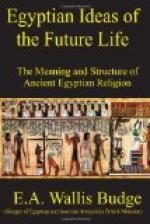This Chapter is most important as showing that the deceased wished to have his homestead and its fields situated in Tattu, that is to say, near the capital of the Busirite or IXth nome of Lower Egypt, a district not far from the city of Semennud (i.e., Sebennytus) and lying a little to the south of the thirty-first parallel of latitude. It was here that the reconstitution of the dismembered body of Osiris took place, and it was here that the solemn ceremony of setting up the backbone of Osiris was performed each year. The original Sekhet-Aaru was evidently placed here, and we are therefore right in assuming that the fertile fields of this part of the Delta formed the prototype of the Elysian Fields of the Egyptian. At the same time he also wished to reap crops on the fields round about Heliopolis, the seat of the greatest and most ancient shrine of the Sun-god. The white grain of which he would have his bread made is the ordinary dhura, and the red grain is the red species of the same plant, which is not so common as the white. As keepers of the door of his estate the deceased asks for the “forms (or persons) of his father and his mother,” and thus we see a desire on the part of the Egyptian to continue the family life which he began upon earth; it goes almost without saying that he would not ask this thing if he thought there would be no prospect of knowing his parents in the next world. An interesting proof of this is afforded by the picture of the Sekhet-Aaru, or Elysian Fields, which is given in the Papyrus of Anhai, [Footnote: Brit. Mus., No. 10,472.] [Illustration: Anhai bowing before her father and mother. The Elysian Fields. From the Papyrus of Anhai (XXIInd dynasty).] a priestess of Amen who lived probably about B.C. 1000. Here we see the deceased entering into the topmost section of the district and addressing two divine persons; above one of these are written the words “her mother,” followed by the name Neferitu. The form which comes next is probably that of her father, and thus we are sure that the Egyptians believed they would meet their relatives in the next world and know and be known by them.
Accompanying the picture of the Elysian Fields is a long text which forms Chapter CX. of the Book of the Dead. As it supplies a great deal of information concerning the views held in early times about that region, and throws so much light upon the semi-material life which the pious Egyptians, at one period of their history, hoped to lead, a rendering of it is here given. It is entitled, “The Chapters of Sekhet-Hetepet, and the Chapters of Coming Forth by Day; of going into and of coming forth from the underworld; of coming to Sekhet-Aaru; of being in Sekhet-Hetepet, the mighty land, the lady of winds; of having power there; of becoming a spirit (KHU) there; of reaping there; of eating there; of drinking there; of making love there; and of doing everything even as a man doeth upon the earth.” The deceased says:—




